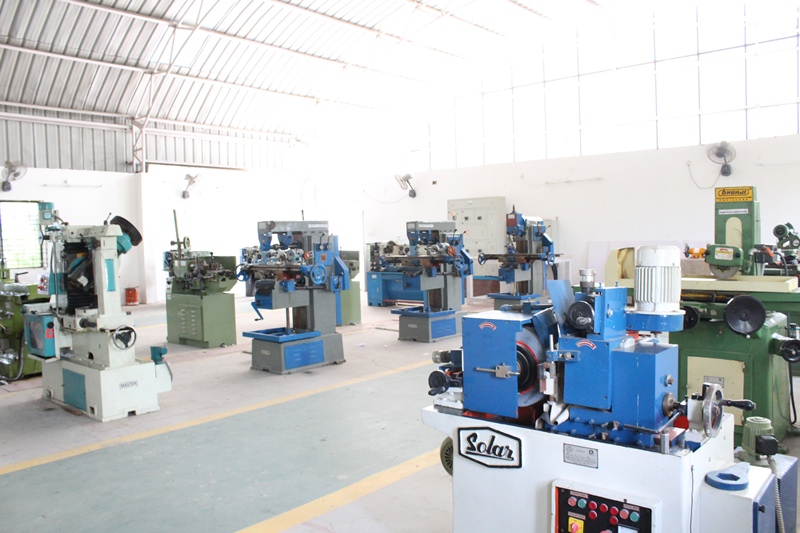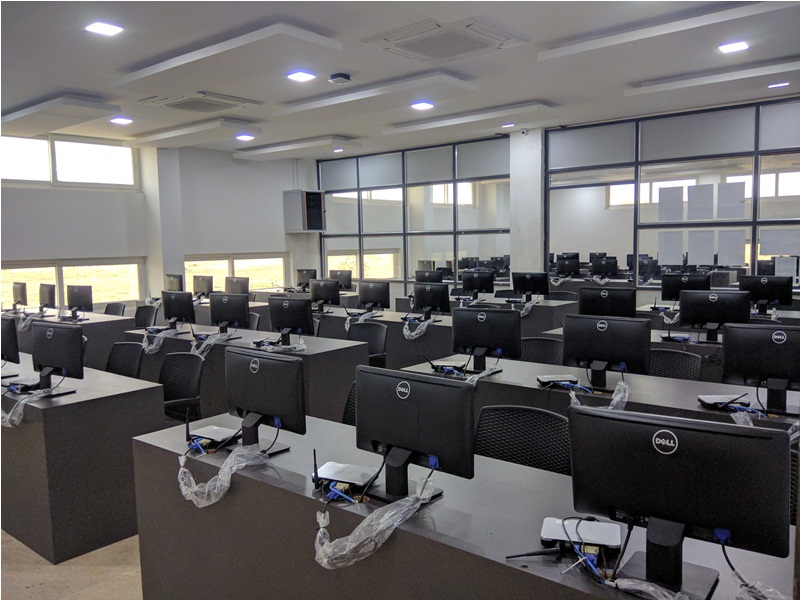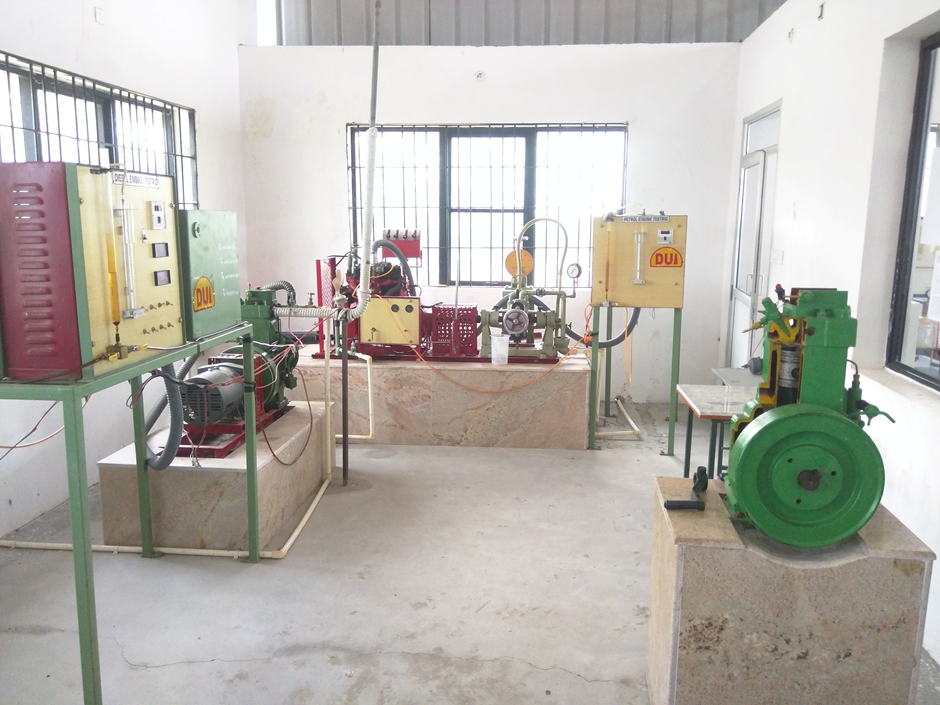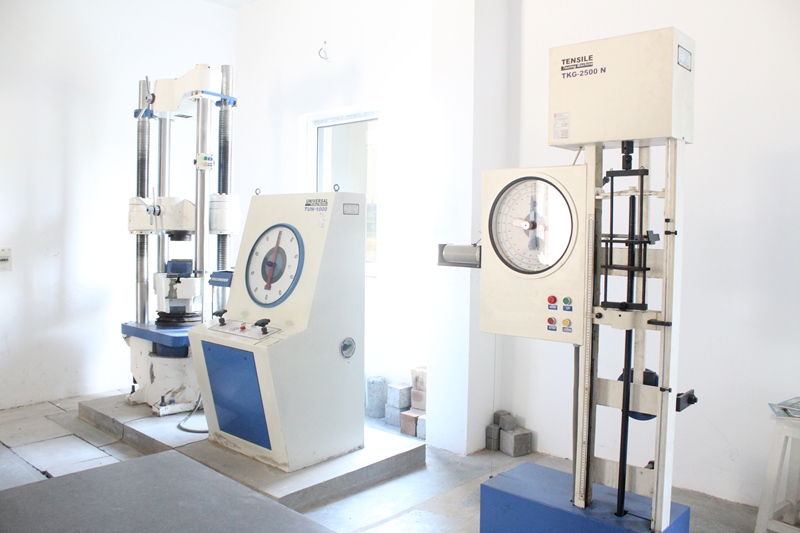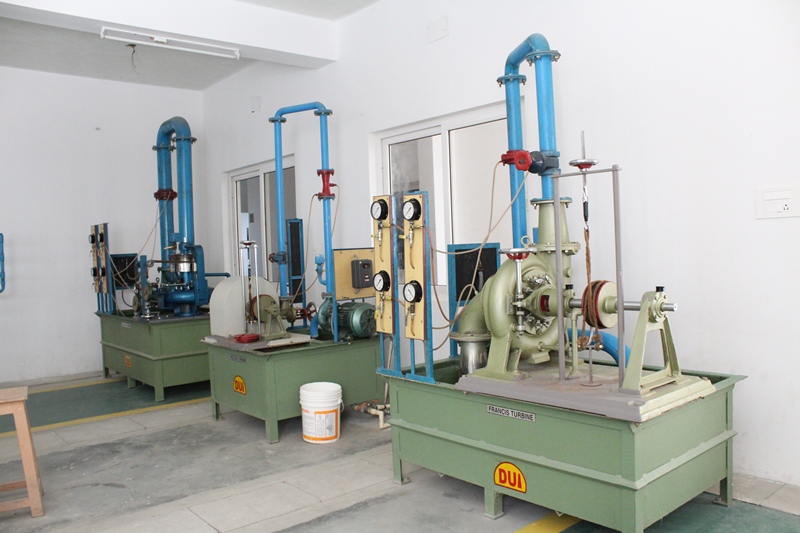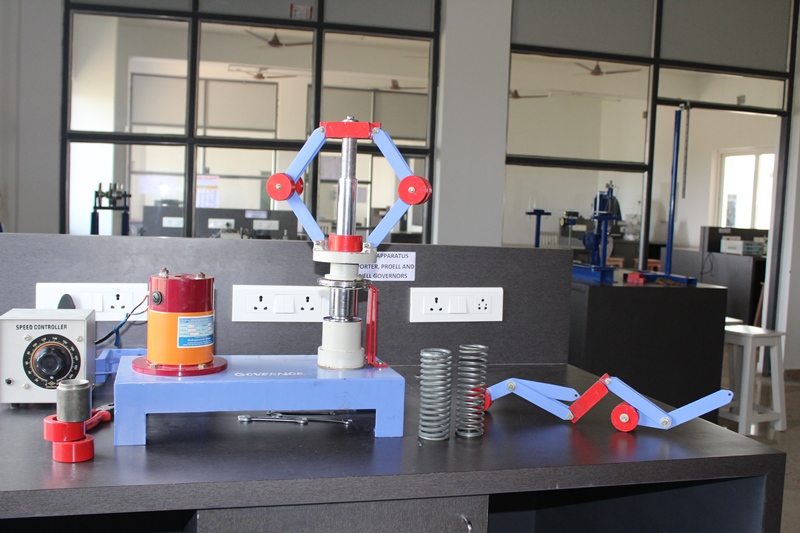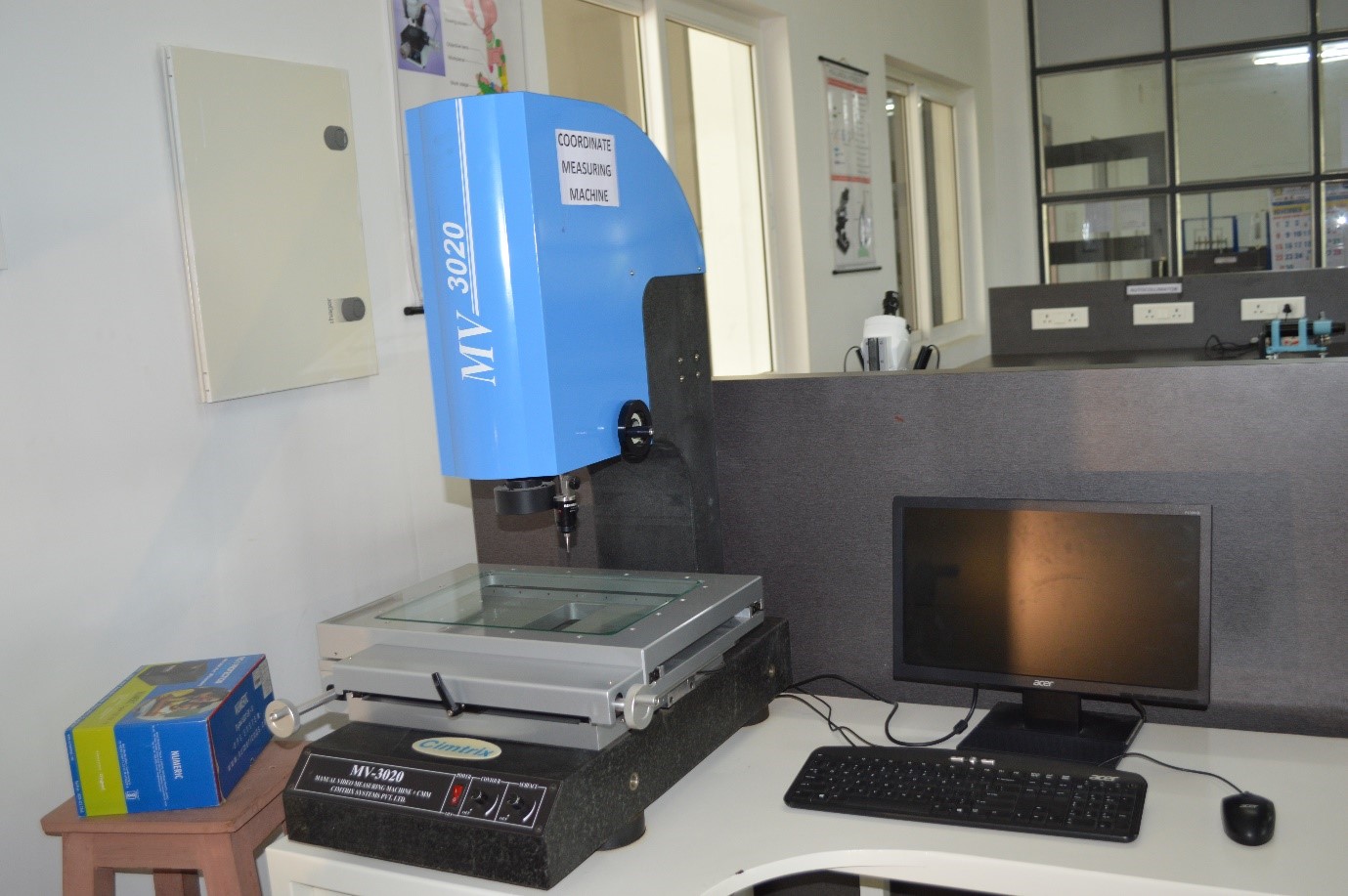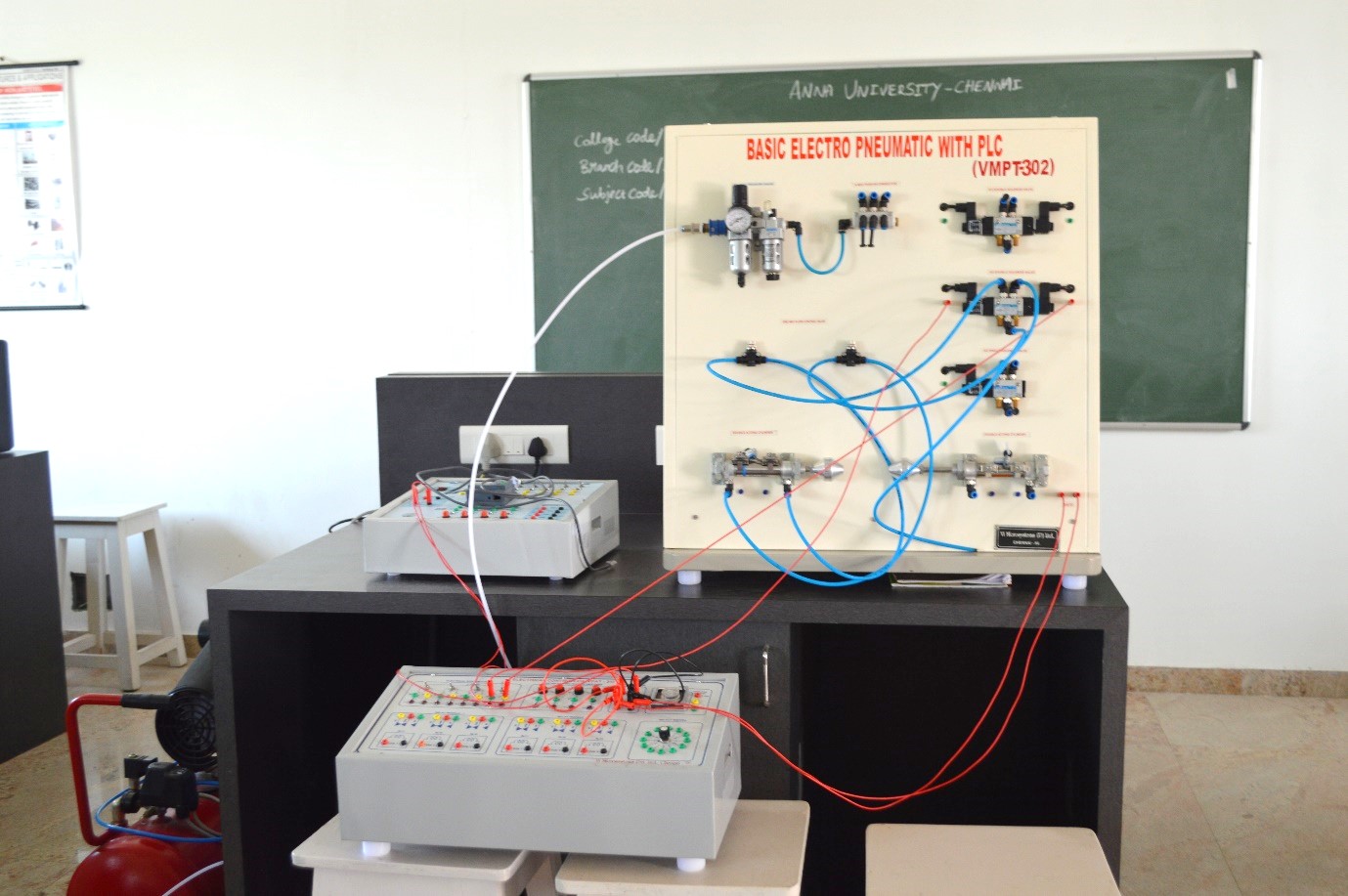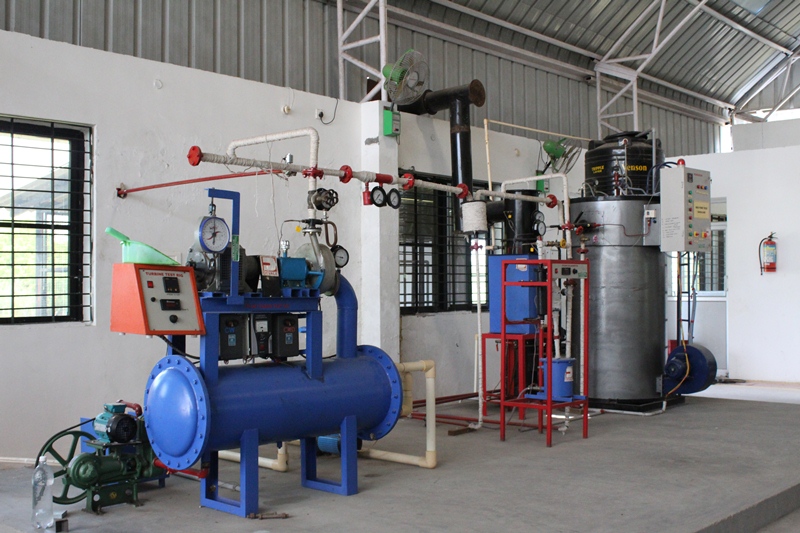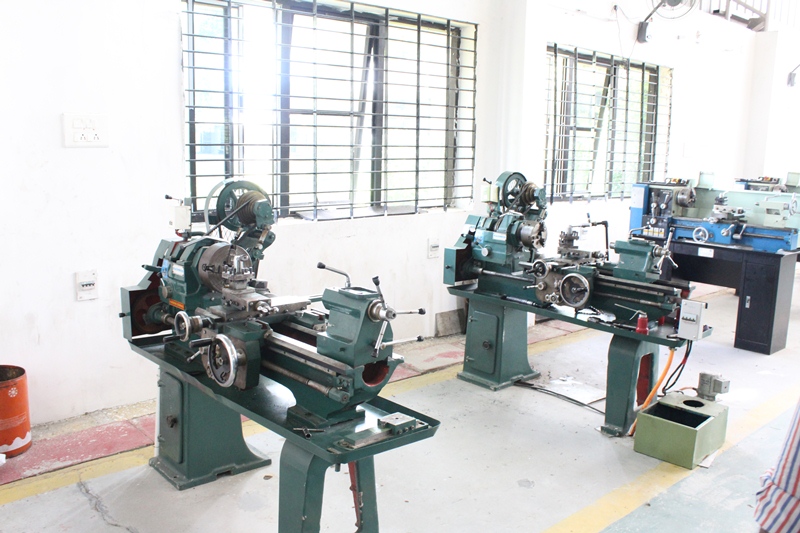Mechanical Engineering
Mechanical Engineering education is a very strategic and specialized segment where the engineers are being trained to meet the innovative demands of futuristic technologies. Our department offers world class facilities to create students as global leaders in Engineering & Technology to provide solutions to real time problems and innovate new ideas.
Mechanical Engineering is one of the oldest and broadest engineering disciplines, which requires a solid understanding of core concepts including mechanics, kinematics, thermodynamics, fluid flow and Heat transfer, Computer integrated Manufacturing, materials science and energy. Students are trained to use the core principles as well as other knowledge in the field to design and analyze manufacturing plants, industrial equipment and machinery, heating and cooling systems, motor vehicles, aircraft, robotics and energy saving devices.
Through project work, students can choose to use nationally-recognised materials characterisation facilities, explore the cross-disciplinary aspect of mechanical engineering, applying their skills in areas ranging from 3D printing to Space technology.
The Department of Mechanical Engineering is committed to blossom into Centre of Excellence and research leading to well qualified engineers, who will be innovative, entrepreneurial and successful in advanced fields to cater the ever changing industrial demands and social needs. Department is also encouraging our faculties for quality improvement programs to learn latest change and trends in their respective fields.
Professional student chapters like ISHRAE, SAE are functioning to conduct technical activities for the students. Department of Mechanical Engineering is committed to promote technological advancement apart from curriculum through various activities like hands-on practice, expert talks, industrial visits, having MOU with several industries, skill development workshops and conventional technologies.
Vision
- Emerge as an eminent center of excellence in Mechanical Engineering for quality technical education and scientific research leading to social development.
Mission
- To impart quality education to create efficient Mechanical Engineers through eminent faculty.
- To provide the state-of-the art infrastructure to facilitate the cutting edge research in emerging field of Mechanical Engineering.
- To undertake multidisciplinary and collaborative projects with industries and research organizations.
- To serve the society by developing competent engineers and entrepreneurs with outstanding leadership qualities and moral values.
Program Specific Outcomes (PSOs)
- Ability to apply the basic knowledge to identify, formulate and solve problems in the domains of thermal, machine design, manufacturing and industrial engineering.
- Ability to provide solutions to complex Mechanical Engineering problems by acquiring technological inputs and managerial skills and utilizing advanced technology with the help of modern CAD/CAM/CAE tools
- Ability to develop mechanical and allied products with socio-economic concern by applying innovative ideas under ethical and professional constraints leading to a successful career.
Program Educational Objectives (PEOs)
- The graduates will possess in-depth knowledge in the field of Mechanical Engineering and have a successful professional career in industry or by becoming an entrepreneur or by pursuing higher education and research.
- The graduates will demonstrate profound problem solving skills and improved ability to design, develop economic and environment friendly Mechanical systems for multi-disciplinary societal needs.
- The graduates will have ethical attitude and leadership quality to work efficiently with diverse teams, adapt to recent technologies by lifelong learning to solve real life problems.
|
Course Code & Name |
Course Outcome No. |
Course Outcomes |
|
SEMESTER – I |
||
|
After completion of the course, the students will be able to |
||
|
HS8151 & Communicative English |
1 |
Build listening skills to acknowledge formal and informal conversations |
|
2 |
Illustrate the various kinds of Grammar in speaking etiquette |
|
|
3 |
Describe the narrative techniques in Communication |
|
|
4 |
Interpret writings and formulate simple sentences in English |
|
|
5 |
Classify the main and sub-ordinate ideas in writing |
|
|
MA8151 & Engineering Mathematics – I |
1 |
Apply limits and differentiation to differentiate functions and solve maxima and minima problems. |
|
2 |
Evaluate integrals using Riemann sums and Fundamental Theorem of Calculus. |
|
|
3 |
Apply integration to compute multiple integrals, area, volume, integrals in polar coordinates, in addition to change of order and change of variables |
|
|
4 |
Evaluate integrals by using techniques of integration, such as substitution, partial fractions and integration by parts |
|
|
5 |
Determine convergence/divergence of improper integrals and evaluate convergent improper integrals. Apply various techniques in solving differential equations |
|
|
PH8151 & Engineering Physics |
1 |
Describe the fundamentals of properties of matter to formulate and analyze the problems in columns and beams. |
|
2 |
Summarize the concepts and applications of waves, lasers and fiber optics to give theoretical approaches to design modern devices. |
|
|
3 |
Identify the thermal properties of materials required for expansion joints and heat exchangers and determine the heat flow. |
|
|
4 |
Explain the concepts of advanced quantum theory and its applications in tunneling microscopes for both the mathematical and physical prediction. |
|
|
5 |
Explain the basics of crystals, their structures and different crystal growth techniques to understand the behavior of the solids. |
|
|
CY8151 & Engineering Chemistry |
1 |
Illustrate the methods of water softening, requirements of boiler feed water and water treatment methods. |
|
2 |
Explain catalysis theories and adsorption concepts used in pollution abatement. |
|
|
3 |
Identify the eutectic mixtures of suitable alloys for the replacement of traditional materials in Engineering applications. |
|
|
4 |
Describe methods of fuel manufacture and calculation of calorific value to meet desired needs within realistic constraints. |
|
|
5 |
Explain the principle and generation of energy in batteries, nuclear reactors, solar cells, wind mills and fuel cells to give an idea about various energy sources and storage devices. |
|
|
GE8151 & Problem Solving and Python Programming |
1 |
Develop algorithmic solutions to simple computational problems |
|
2 |
Read, write, and execute simple Python programs. |
|
|
3 |
Develop simple Python programs for solving problems and decompose them into functions |
|
|
4 |
Represent compound data using Python lists, tuples, dictionaries |
|
|
5 |
Describe the methods to read and write data from/to files in python programs |
|
|
GE8152 & Engineering Graphics |
1 |
Perform freehand sketching of basic geometrical constructions and multiple views of objects and conic sections. |
|
2 |
Develop orthographic projections of lines and plane surfaces |
|
|
3 |
Draw projections of solids |
|
|
4 |
Draw projections of sectional views and development of surfaces |
|
|
5 |
Visualize and project isometric and perspective sections of simple solids |
|
|
GE8161 & Problem Solving and Python Programming Laboratory |
1 |
Solve simple computational problems using python programs |
|
2 |
Solve problems using conditions & loops in python |
|
|
3 |
Develop Python programs by defining functions and calling them |
|
|
4 |
Apply python list, tuples and dictionaries for representing compound data |
|
|
5 |
Develop python programs using files |
|
|
BS8161 & Physics and Chemistry Laboratory |
1 |
Demonstrate the basic concepts like torque, elasticity and bending moment of beams for various engineering applications by the determination of rigidity modulus of the wire and young’s modulus of the material of the beam by non-uniform bending. |
|
2 |
Identify the fundamentals of thermal properties of material of the bad conductor by Lee’s disc method. |
|
|
3 |
Demonstrate the estimation of DO content in water sample by Winkler’s method and molecular weight of polymer by Ostwald viscometer |
|
|
4 |
Determine the strength of an acid using pH meter and conductometer |
|
|
5 |
Demonstrate the estimation of weak and strong acids in a mixture by conductometer |
|
|
SEMESTER – II |
||
|
HS8251 & Technical English |
1 |
Develop the listening skill to comprehend lectures and talk in their area of specialization successfully. |
|
2 |
Improve the speaking ability to communicate effectively in varied formal and informal contexts. |
|
|
3 |
Build the reading proficiency for effective understanding of scientific and technical reports. |
|
|
4 |
Construct sentences successfully for effective writing of journal papers and job winning applications. |
|
|
5 |
Enhance communication skills for competent reporting and presenting among the engineering community. |
|
|
MA8251 & Engineering Mathematics – II |
1 |
Apply the idea of reducing complex problems into simple form using matrix technique. |
|
2 |
Apply line, surface and volume integrals using Gauss, Stokes and Green’s theorems and verify |
|
|
3 |
Apply Analytic functions, conformal mapping and complex integration to simplify complex problems |
|
|
4 |
Apply various techniques in solving complex integration problem to simple problem by using residue technique |
|
|
5 |
Apply Laplace transform and inverse Laplace transform to solve differential equations with constant coefficients |
|
|
PH8251 – Materials Science |
1 |
knowledge on Cu-Ni, Pb-Sn and Ag-Pt phase diagrams and their applications |
|
2 |
know the Fe-Fe3C & Fe-C phase diagram and TTT Diagram of various alloys and its microstructures and Stainless Steel |
|
|
3 |
gain knowledge on mechanical properties of materials and their measurements |
|
|
4 |
Realize the working of Magnetism, Dielectric and Superconducting materials. |
|
|
5 |
Identify the emerging applications with Nano devices and ceramics materials |
|
|
BE8253 Basic Electrical, Electronics and Instrumentation Engineering
|
1 |
Determine current and voltage in circuits using Ohm’s Law, Kirchhoff’s laws, mesh current method, node voltage method and network topology. |
|
2 |
Outline the concepts of AC circuits and Different types of Wiring used in Industries and Houses |
|
|
3 |
Explain the construction and principle of operation of electrical machines for various applications. |
|
|
4 |
Illustrate the characteristics of several semiconductor devices such as PN junction diode, Zener diode and Bipolar Junction Transistor with its applications. |
|
|
5 |
Choose appropriate instruments for electrical measurement in Mechanical for a specific application. |
|
|
GE8291 & Environmental Science and Engineering |
1 |
Explain the values, threats and conservation of biodiversity and classify various Ecosystems. |
|
2 |
Identify and implement technological and economical solution to environmental pollution. |
|
|
3 |
Develop the knowledge on various natural resources, their causes and their effects. |
|
|
4 |
Illustrate the methods of disaster management and specify the legal responsibilities of an individual. |
|
|
5 |
Describe the need of awareness about population growth, family welfare, value education and role of IT in environment and human health. |
|
|
GE8292 Engineering Mechanics |
1 |
Illustrate the vectorial and scalar representation of forces and moments |
|
2 |
Analyze the rigid body in equilibrium |
|
|
3 |
Evaluate the properties of surfaces and solids |
|
|
4 |
Calculate dynamic forces exerted in rigid body |
|
|
5 |
Determine the friction and the effects by the laws of friction |
|
|
GE8261 & Engineering Practices Laboratory |
1 |
Develop pipe connections with mixed material, joining components and prepare plumbing line sketches for water treatment, sewage works and highrise buildings |
|
2 |
Develop models and joints using sheet metal, carpentry and fitting works |
|
|
3 |
Illustrate the use of arc and gas welding to prepare joints and demonstrate basic machining, smithy and foundry operations |
|
|
4 |
Demonstrate the basic home electrical wiring work and measure the electrical quantities such as energy, current, voltage, power, power factor and resistance to earth |
|
|
5 |
Demonstrate the applications of electronics components, gates using simple circuits |
|
|
BE8261 Basic Electrical, Electronics and Instrumentation Engineering Laboratory
|
1 |
Determine the speed characteristic of different electrical machines. |
|
2 |
Draw the performance characteristics of various D.C. Motors and understand the applications of it to power system |
|
|
3 |
Design simple circuits involving diodes and transistors. |
|
|
4 |
Determine current and voltage in circuits using electrical network theorems. |
|
|
SEMESTER – III |
||
|
MA8353 Transforms and Partial Differential Equations |
1 |
Solve differential equations in vibration analysis and signal processing by using Fourier series. |
|
2 |
Apply Fourier series techniques to solve one and two dimensional heat flow problems and also one dimensional wave equations. |
|
|
3 |
Apply the mathematical principles on transforms and partial differential equations to formulate and solve physical problems in engineering. |
|
|
4 |
Apply Z transform techniques to solve Partial Differential equations and discrete time systems |
|
|
5 |
Apply partial differential equation concepts in solving homogeneous and non- homogeneous equations. |
|
|
ME8391 Engineering Thermodynamics |
1 |
Apply the first law of thermodynamics for open and closed systems. |
|
2 |
Apply second law of thermodynamics for open and closed systems |
|
|
3 |
Apply Rankine cycle to steam power plant and compare cycle improvement methods |
|
|
4 |
Derive thermodynamic relations of ideal and real gases |
|
|
5 |
Calculate the properties of gas mixtures and moist air and its use in psychometric processes |
|
|
CE8394 Fluid Mechanics and Machinery |
1 |
Calculate the effect of fluid properties and characteristics of fluid flow |
|
2 |
Compute losses in circular conduits using conservation laws |
|
|
3 |
Perform dimensional analysis in fluid flow problem and relate the model and prototype |
|
|
4 |
Analyze the performance of pumps |
|
|
5 |
Analyze the performance of hydraulic machines. |
|
|
ME8351 Manufacturing Technology – I
|
1 |
Explain different metal casting processes, associated defects, merits and demerits |
|
2 |
Compare different metal joining processes. |
|
|
3 |
Summarize various hot working and cold working methods of metals. |
|
|
4 |
Explain various sheet metal making processes. |
|
|
5 |
Distinguish various methods of manufacturing plastic components. |
|
|
EE8353 Electrical Drives and Controls |
1 |
explain the elements of electrical drives |
|
2 |
explain drive motor characteristics |
|
|
3 |
summarize the starting method of motors |
|
|
4 |
infer the concepts of Solid State Control of DC and AC drives |
|
|
5 |
apply the control of DC and AC drives |
|
|
ME8361 Manufacturing Technology Laboratory – I |
1 |
Demonstrate the safety precautions exercised in the mechanical workshop. |
|
2 |
Make the work piece as per given shape and size using Lathe. |
|
|
3 |
Join two metals using arc welding or gas welding |
|
|
4 |
Use sheet metal fabrication tools and make simple tray and funnel. |
|
|
5 |
Use different moulding tools, patterns and prepare sand moulds. |
|
|
ME8381 Computer Aided Machine Drawing |
1 |
Follow the drawing standards, Fits and Tolerances |
|
2 |
Re-create part drawings, sectional views and assembly drawings as per standards |
|
|
EE8361 Electrical Engineering Laboratory
|
1 |
Determine the performance of various D.C. Generators and understand the applications of it to power system |
|
2 |
Draw the performance characteristics of various D.C. Motors and understand the applications of it to power system |
|
|
3 |
Calculate the voltage regulation and predetermine the performance of the single phase and three phase transformer |
|
|
4 |
Determine the voltage regulation of three phase alternator in different methods and compare the results. |
|
|
HS8381 & Interpersonal Skills/Listening & Speaking |
1 |
Listen and respond appropriately. |
|
2 |
Participate in group discussions |
|
|
3 |
Make effective presentations |
|
|
4 |
Participate confidently and appropriately in conversations both formal and informal |
|
|
SEMESTER – IV |
||
|
MA8452 – Statistics and Numerical Methods |
1 |
Analyze the null hypothesis for large and small number of samples |
|
2 |
Apply hypothesis testing using design of experiments |
|
|
3 |
Solve root finding problems using several methods |
|
|
4 |
Apply numerical techniques of interpolation in various intervals and numerical techniques of differentiation and integration in engineering problems |
|
|
5 |
Solve ordinary differential equation problems using various methods. |
|
|
ME8492 Kinematics of Machinery |
1 |
Discuss the basics of mechanism |
|
2 |
Analyze the assembly with respect to the displacement, velocity and acceleration |
|
|
3 |
Develop CAM profiles for different types of motions |
|
|
4 |
Analysis the design parameters of gears and gear trains |
|
|
5 |
Analysis friction in machine elements |
|
|
ME8451 Manufacturing Technology– II |
1 |
Explain the mechanism of material removal processes. |
|
2 |
Describe the constructional and operational features of centre lathe and other special purpose lathes. |
|
|
3 |
Describe the constructional and operational features of shaper, planner, milling, drilling, sawing and broaching machines. |
|
|
4 |
Explain the types of grinding and other super finishing processes apart from gear manufacturing processes. |
|
|
5 |
Summarize numerical control of machine tools and write part program. |
|
|
ME8491 Engineering Metallurgy |
1 |
Explain alloys and phase diagram, Iron-Iron carbon diagram and steel classification. |
|
2 |
Explain isothermal transformation, continuous cooling diagrams and different heat treatment processes. |
|
|
3 |
Analysis the effect of alloying elements on ferrous and non-ferrous metals |
|
|
4 |
Summarize the properties and applications of non-metallic materials. |
|
|
5 |
Explain the testing of mechanical properties. |
|
|
CE8395 Strength of Materials for Mechanical Engineers |
1 |
Summarize the concepts of stress and strain, principal stresses and principal planes. |
|
2 |
Determine Shear force and bending moment in beams using the theory of simple bending |
|
|
3 |
Apply Macaulay’s and double integration methods to find the deflection of beams |
|
|
4 |
Design circular shafts and helical springs using basic equations of torsion |
|
|
5 |
Analyse and design of thin spheres and thick shells |
|
|
ME8493 Thermal Engineering – I |
1 |
Apply thermodynamic concepts to different air standard cycles and solve problems |
|
2 |
Determine the performance of single stage and multistage air compressors. |
|
|
3 |
Explain the functioning and features of IC engines, components and auxiliaries. |
|
|
4 |
Calculate performance parameters of IC Engines. |
|
|
5 |
Analysis performance and it is parameters of gas turbine |
|
|
ME8462 Manufacturing Technology Laboratory–II |
1 |
Use different machine tools to manufacturing gears |
|
2 |
Use different machine tools for finishing operations |
|
|
3 |
Manufacture tools using cutter grinder |
|
|
4 |
Develop CNC part programming |
|
|
CE8381 Strength of Materials and Fluid Mechanics and Machinery Laboratory |
1 |
Perform Tension, Torsion, Hardness, Compression, and Deformation test on Solid materials. |
|
2 |
Use the measurement equipment’s for flow measurement |
|
|
3 |
Perform test on different fluid machinery. |
|
|
HS8461 & Advanced Reading and Writing |
1 |
Write different types of essays. |
|
2 |
Write winning job applications. |
|
|
3 |
Read and evaluate texts critically. |
|
|
4 |
Display critical thinking in various professional contexts. |
|
|
SEMESTER – V |
||
|
ME8595 – Thermal Engineering – II |
1 |
Analysis the flow of steam through nozzle by using steady state equations |
|
2 |
Explain the functioning and features of different types of Boilers and auxiliaries and calculate performance parameters. |
|
|
3 |
Determine the efficiency of steam turbine from velocity diagram |
|
|
4 |
Summarize the concept of Cogeneration, Working features of Heat pumps and Heat exchangers |
|
|
5 |
Determine performance of refrigeration and air conditioning using refrigeration table and charts |
|
|
ME8593 Design of Machine Elements |
1 |
Explain the influence of steady and variable stresses in machine component design. |
|
2 |
Design to shafts, keys and couplings bsaed on strength. |
|
|
3 |
Apply the concepts of design to temporary and permanent joints. |
|
|
4 |
Design energy absorbing members in connecting rod and crank shaft |
|
|
5 |
Apply the concepts of design to bearings. |
|
|
ME8501 Metrology and Measurements |
1 |
Describe the concepts of measurements to apply in various metrological instruments |
|
2 |
Outline the principles of linear and angular measurement tools used for industrial applications |
|
|
3 |
Explain the procedure for conducting computer aided inspection |
|
|
4 |
Demonstrate the techniques of form measurement used for industrial components |
|
|
5 |
Discuss various measuring techniques of mechanical properties in industrial applications |
|
|
ME8594 Dynamics of Machines |
1 |
Find static and dynamic forces of mechanisms |
|
2 |
Calculate the balancing masses and their locations of reciprocating and rotating masses |
|
|
3 |
Determine the frequency of free vibration and damping |
|
|
4 |
Compute the frequency of forced vibration and damping coefficient |
|
|
5 |
Calculate the governor variables and estimate the gyroscopic effect on automobiles, ships and airplanes |
|
|
OAN551 & Sensors and Transducers
|
1 |
Expertise in various calibration techniques and signal types for sensors. |
|
2 |
Apply the motion, proximity and ranging sensors in the Automotive and Mechatronics applications. |
|
|
3 |
Apply the force, magnetic and heading sensors in the Automotive and Mechatronics applications. |
|
|
4 |
Explain the basic principles of the optical, pressure and temperature sensors and various smart sensors. |
|
|
5 |
Implement the DAQ systems with different sensors for real time applications. |
|
|
ME8511 Kinematics and Dynamics Laboratory |
1 |
Demonstrate the principles of kinematics and dynamics of machinery |
|
2 |
Use the measuring devices for dynamic testing |
|
|
ME8512 Thermal Engineering Laboratory |
1 |
Conduct tests on heat conduction apparatus and evaluate thermal conductivity of materials |
|
2 |
Conduct tests on natural and forced convective heat transfer apparatus and evaluate heat transfer coefficient |
|
|
3 |
Conduct tests on radioactive heat transfer apparatus and evaluate Stefan Boltzmann constant and emissivity |
|
|
4 |
Conduct tests to evaluate the performance of parallel/counter flow heat exchanger apparatus and reciprocating air compressor |
|
|
5 |
Conduct tests to evaluate the performance of refrigeration and air conditioning test rigs |
|
|
ME8513 Metrology and Measurements Laboratory |
1 |
Measure the gear tooth dimensions, angle using sine bar, straightness and flatness, thread parameters, temperature using thermocouple, force, displacement, torque and vibration |
|
2 |
Calibrate the vernier, micrometer and slip gauges and setting up the comparator for the inspection |
|
|
SEMESTER – VI |
||
|
ME8651 Design of Transmission Systems |
1 |
Apply the design concepts to belts, chains and rope drives |
|
2 |
Design spur, helical gears |
|
|
3 |
Design worm and bevel gears |
|
|
4 |
Design gear boxes |
|
|
5 |
Apply the concepts of design to cams, clutches and brakes |
|
|
ME8691 Computer Aided Design and Manufacturing |
1 |
Describe fundamentals of Computer Graphics |
|
2 |
Explain the different type of geometric modelling techniques |
|
|
3 |
Describe the various algorithms for visual realism |
|
|
4 |
Describe the assembly modeling approaches |
|
|
5 |
Explain the different CAD/CAM data exchange standards |
|
|
ME8693 Heat and Mass Transfer |
1 |
Apply heat conduction equations to different surface configurations under steady state and transient conditions to solve problems |
|
2 |
Apply convective heat transfer correlations to internal and external flows through various surface configurations and solve problems |
|
|
3 |
Explain the phenomena of boiling and condensation and thermal analysis of different types of heat exchanger configurations and solve problems |
|
|
4 |
Explain basic laws for Radiation and apply principles to different types of surfaces to solve problems |
|
|
5 |
Apply diffusive and convective mass transfer equations and correlations to solve problems for different applications |
|
|
ME8692 Finite Element Analysis |
1 |
Express the various approximation and elimination methods to find the solution. |
|
2 |
Solve various numerical engineering problems in 1D bar & Truss element. |
|
|
3 |
Ability to use fem analysis in structural and thermal problem. |
|
|
4 |
Compile the elements in CST & Axisymmetric. |
|
|
5 |
Expose the difference between iso, super and sub parametric elements. |
|
|
ME8694 Hydraulics and Pneumatics |
1 |
Explain the Fluid power and operation of different types of pumps. |
|
2 |
Summarize the features and functions of Hydraulic motors, actuators and Flow control valves |
|
|
3 |
Explain the different types of Hydraulic and Pneumatic circuits and systems |
|
|
4 |
Explain the working of different pneumatic circuits and systems |
|
|
5 |
Summarize various chemical and electrochemical energy based process |
|
|
ME8091 Automobile Engineering |
1 |
Recognize the various parts of the automobile and their functions and materials. |
|
2 |
Discuss the engine auxiliary systems and engine emission control. |
|
|
3 |
Distinguish the working of different types of transmission systems. |
|
|
4 |
Explain the Steering, Brakes and Suspension Systems. |
|
|
5 |
Predict possible alternate sources of energy for IC Engines. |
|
|
ME8681 C.A.D / C.A.M. Laboratory |
1 |
Ability to develop 2D and 3D models using modeling softwares. |
|
2 |
Ability to understand the CNC control in modern manufacturing system. |
|
|
3 |
Ability to prepare CNC part programming and perform manufacturing. |
|
|
ME8682 Design and Fabrication Project |
1 |
Review the literature and gather information pertaining to the chosen topic. |
|
2 |
Design and develop the machine element or mechanical product |
|
|
3 |
Carry out the fabrication work and demonstrate the model developed |
|
|
HS8581 & Professional Communication |
1 |
Make effective presentations |
|
2 |
Participate confidently in group discussions. |
|
|
3 |
Attend job interviews and be successful in them |
|
|
4 |
Develop adequate soft skills required for the work place |
|
|
SEMESTER – VII |
||
|
ME8792 Power Plant Engineering |
1 |
Explain the layout, construction and working of the components inside a thermal power plant. |
|
2 |
Explain the layout, construction and working of the components inside diesel and gas turbine power plant. |
|
|
3 |
Explain the layout, construction and working of the components inside nuclear power plant. |
|
|
4 |
Explain the working principle of renewable energy power plants and direct energy conversion systems |
|
|
5 |
Estimate Load curves, Load duration curves, the cost of electricity energy production & Environmental hazards |
|
|
ME8793 Process Planning and Cost Estimation |
1 |
Select the process, equipment and tools for various industrial products. |
|
2 |
Prepare process planning activity chart. |
|
|
3 |
Explain the concept of cost estimation. |
|
|
4 |
Compute the job order cost for different type of shop floor. |
|
|
5 |
Calculate the machining time for various machining operations. |
|
|
ME8791Mechatronics |
1 |
Discuss the interdisciplinary applications of Electronics, Electrical, Mechanical and Computer Systems for the Control of Mechanical, Electronic Systems and sensor technology. |
|
2 |
Discuss the architecture of Microprocessor and Microcontroller, Pin Diagram, AddressingModes of Microprocessor and Microcontroller. |
|
|
3 |
Discuss Programmable Peripheral Interface, Architecture of 8255 PPI, and various device interfacing |
|
|
4 |
Explain the architecture, programming and application of programmable logic controllersto problems and challenges in the areas of Mechatronic engineering. |
|
|
5 |
Discuss various Actuators and Mechatronics system using the knowledge and skills acquired through the course and also from the given case studies |
|
|
ME8099 & Robotics |
1 |
Explain the concepts of industrial robots, classification, specifications and coordinate systems. Also summarize the need and application of robots in different sectors. |
|
2 |
Illustrate the different types of robot drive systems as well as robot end effectors. |
|
|
3 |
Apply the different sensors and image processing techniques in robotics to improve the ability of robots. |
|
|
4 |
Develop robotic programs for different tasks and familiarize with the kinematics motions ofrobot. |
|
|
5 |
Examine the implementation of robots in various industrial sectors and interpolate the economic analysis of robots. |
|
|
GE8077 & Total Quality Management |
1 |
Develop an understanding of quality management philosophies and Framework. |
|
2 |
Discuss the need of customer expectations, employee involvement and Supplier partnership. |
|
|
3 |
Analyze the TQM tools and Techniques to improve the product and process Quality. |
|
|
4 |
Apply modern tools to improve quality of the product. |
|
|
5 |
Explain about ISO 9001, Environmental Management Standards and ISO 14001 Certification process. |
|
|
ME6019 Non Destructive Testing and Materials |
1 |
Upon completion of this course, the students can able to use the various Non-Destructive Testing and Testing methods understand for defects and characterization of industrial components. |
|
2 |
Students understand the concept and working of penetrant testing and Magnetic Particle Testing. |
|
|
3 |
The students will learn about the sub surface defects through the thermography tests and eddy current testing. |
|
|
4 |
The students can the concepts and functioning of Ultrasonic Testing and Acoustic Testing. |
|
|
5 |
The students will the various procedures and types of Radiography tests |
|
|
ME8711 Simulation and Analysis Laboratory |
1 |
Upon completion of this course, the Students can model, analyse and simulate experiments to meet real world system and evaluate the performance |
|
ME8781 Mechatronics Laboratory |
1 |
Demonstrate the functioning of mechatronics system with various pneumatic, hydraulic and electrical systems |
|
2 |
Demonstrate the functioning of control systems with the help of PLC and microcontrollers |
|
|
ME8712 Technical seminar |
1 |
Technical seminar on any given problem related to mechanical engineering field. |
|
SEMESTER – VIII |
||
|
MG8591 & Principles of Management
|
1 |
Discuss the evolution of management, functions and roles of managers. |
|
2 |
Explain the different types of plans, Steps in planning process and tools used for planning. |
|
|
3 |
Elaborate different organization structures and functions of human resources manager. |
|
|
4 |
Interpret the concepts in motivation techniques, leadership and communication processes |
|
|
5 |
Describe the control techniques and the role of technology in management |
|
|
GE8076&Professional Ethics in Engineering |
1 |
apply ethics in society |
|
2 |
discuss the ethical issues related to engineering |
|
|
3 |
realize the responsibilities in the society |
|
|
4 |
Know the rights in the society |
|
|
5 |
Understand about global issues |
|
|
ME8811 & Project Work |
1 |
Review the literature and gather information pertaining to the chosen topic. |
|
2 |
Demonstrate the novelty of the project through the results and outputs. |
|
|
3 |
Carry Out the design / fabrication of product or develop computer code. |
|
To effectuate the demands of the industry, we impart practical training to our students through Value Added Courses in their course fields.
3D Printing
3D printing is a way of creating three dimensional (3D) solid objects 3D printing is done by building up the object layer by layer. Usually, 3D printers uses PLA a plastic filament, because it is easier to use and cheaper. Some 3D printers can 3D print with other materials, like metals and ceramics, but they cost too much money for most people.3D printers are useful because they can make new objects very fast, and are good at making them very detailed. This means an engineer can test a lot of new designs and not have to wait for someone else to make them. They are also useful for fixing parts made of plastic, and for making toys, figures, and models. There are a lot of people who print 3D objects at home. In this students can manufacture the components by means of 3D printing.
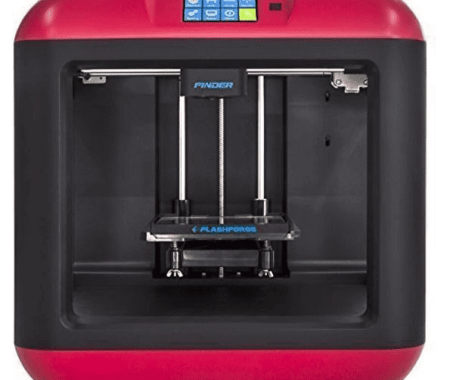
Bosch Diagnostic Lab
The main objective of this Bosch Diagnostic Lab to transfer the current automotive technologies to Students, trains students on the diagnosis, service, repair and troubleshooting of a modern automobile. It is equipped with BOSCH Vehicle diagnosis system, BOSCH Vehicle air-conditioning maintenance system and motion logic drives. The benefit of this Diagnostic Lab enhances their competency levels for better employability. Bosch Diagnostic Lab Established with Bosch Air conditioning service equipment, Wheel balancer, Tyre changer and Head lamp aligner, through this diagnostic lab the students to validate their knowledge and skills at a professional level with internationally reputed BOSCH certification.
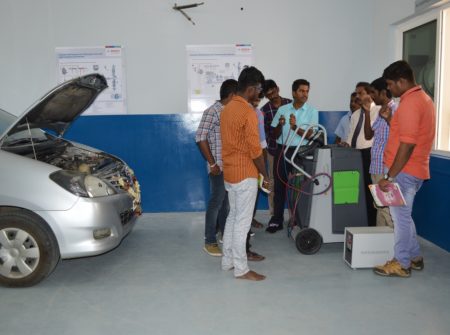
SPRUTCAM / CNC TRAIN
CNC means Computer Numerical Control. This means a computer converts the design produced by Computer Aided Design software (CAD), into numbers. The numbers can be considered to be the coordinates of a graph and they control the movement of the cutter. In industries the CNC machines are used for various machining operations like turning, drilling and milling. The complete process of CNC machining depends on CAD and CAM. The word CAD stands for Computer Aided Design whereas the word CAM stands for Computer Aided Manufacturing. With the help of CAD, one can make 3-D design of the object which anyone have to make and with the help of CAM that design is converted into reality.
ANSYS
ANSYS is Mechanical finite element analysis software is used to simulate computer models of any structures or machine components for analyzing strength, toughness, elasticity, temperature distribution, electromagnetism, fluid flow, and other attributes. It covers an enormous range of applications and comes complete with everything one need from geometry preparation to optimization and all the steps in between. In ANSYS, one can simulate by means of rigid body mechanics and dynamic analysis. The Rigid Body is capability to solve mechanisms rapidly, whereas dynamic analysis includes, linear dynamics, modal, harmonic and random vibration.
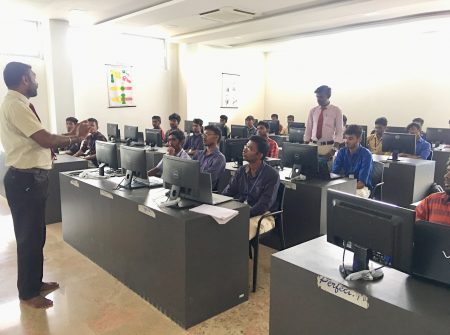
AUTOCAD / CREO / SOLIDWORKS
AUTOCAD / CREO / SOLIDWORKS are basic designing software for mechanical engineers. It provides flexible and user friendly features with the tools to design the applications and document the workflows. This involves aggregate and import models for the formats and usually allows the design to get created without any change in source model. It provides tools to provide the formats by detailed designing the layouts and drawings using the views automatically. It also has the provision to create detailed design layouts and views can be drawn automatically using the source model. AutoCAD is important for engineers to produce 2D and 3D designs. Drawing designs manually consumed enough time. With the software, one can increase the efficiency of their work. The quality of designs improves on using the software.
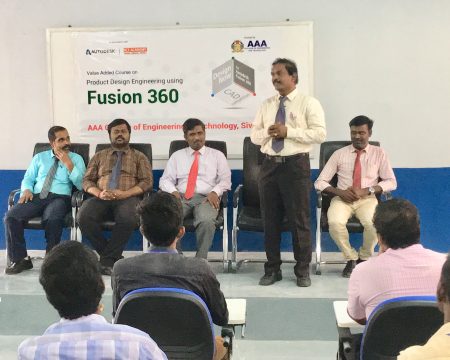
In these software the students will learn about the various symbols, selection of standards in bolts, nuts, screws, keys etc, Limits, Fits and Tolerance of individual dimensions, 2D and 3D models are drawn using the tools like Editing, Dimensioning, Layering, Hatching, Block, Array, Detailing, Sketcher, Datum planes, Protrusion, Holes, Part modeling, Extrusion, Revolve, Sweep, Loft, Blend, Fillet, Pattern, Chamfer, Round, Mirror, Section and Assembly. The assignments are given to make 3D parts of Bearings, Joints, Couplings, Engine parts and miscellaneous machine components.
All department of AAA College of Engineering & Technology organizes several programs in association with professional chapters, Industries, Academicians and Government agencies on a regular basis. The participating students and faculty enhances their knowledge and understanding of the various technological advancements brought to them in the campus through experts. For more details click the below link
Mechanical Activities
The Department of Mechanical Engineering has been one of the core branches of Engineering. It has got wide application in Industries. Mechanical Engineers are required in manufacturing, automobile industry, power plants, aviation industry, nuclear energy and all major industries and small-scale industries as well as in Government sectors. The department has well developed laboratories, infrastructure and ecosystem contributing to wholesome development of the future technocrats.
The department has the following well – developed laboratories
- Manufacturing Technology Laboratory
- CAD / CAM Laboratory
- Thermal Engineering Laboratory (Internal Combustion Engine Laboratory)
- Strength of Materials Laboratory
- Fluid Mechanics & Machines Laboratory
- Dynamics Laboratory
- Metrology & Measurement Laboratory
- Mechatronics Laboratory
- Heat & Mass Transfer Laboratory
- Engineering Practice Laboratory
AAACET has been recognised as Research Center in Mechanical Engineering by the Centre for research, Anna University. Candidates interested to do PhD can officially apply.
|
Sl.No. |
Name of the Research Supervisor |
Supervisor REF. No. |
Research Area |
Email ID |
Contact Number |
|
1. |
Dr.M. Sekar Principal |
3520042 |
Computational Geometry, Micro Machines, Tribology, Vibrations |
– |
|
|
2. |
Dr.P. Seeni Kannan Dean and HoD Mechanical |
2720071 |
Thermal Engineering |
|
9486140536 |
|
3. |
Dr.G. Vairamuthu Associate Professor |
3120009 |
Thermal Engineering, I.C Engines, Alternative Fuels, Energy |
|
9944121594 |
|
4. |
Dr.R.B. Jeen Robert Associate Professor
|
3420009 |
Optimization, Finite Element Analysis, Natural fiber composites |
|
9488081212 |
|
5. |
Dr.R. Selvabharathi Associate Professor |
3320028 |
Welding Technology, Plasma Arc Welding, Optimization Technology, Fuzzy |
|
9486076213 |
FACULTY NAME LIST ACADEMIC YEAR – 2022 – 2023
|
S. No. |
Name |
PAN No. |
Qualification |
Area of Specialization |
Designation |
Date of Joining |
Date on which Designated as Professor/ Associate Professor |
Currently Associated (Y/N) |
Nature of Association (Regular/Contract/ Adjunct) |
If contractual mention Full time or Part time |
Date of Leaving (In case Currently Associated is “No”) |
|
1. |
Dr.P.Seenikannan |
AOSPS6111E |
Ph.D. |
Thermal Engineering |
Dean, Head & Professor |
27.09.2017 |
— |
Yes |
Regular |
— |
— |
|
2. |
Dr.M.Sekar |
AQSPS9953L |
Ph.D. |
Production Engineering |
Principal |
02.07.2018 |
— |
Yes |
Regular |
— |
— |
|
3. |
Dr.G.Vairamuthu |
AJUPV7919G |
Ph.D. |
Thermal Engineering |
Associate Professor |
10.07.2017 |
— |
Yes |
Regular |
— |
— |
|
4. |
Dr.R.B.Jeen Robert |
AIVPJ7945E |
Ph.D. |
Engineering Design |
Associate Professor |
04.07.2016 |
01.03.2019 |
Yes |
Regular |
— |
— |
|
5. |
Dr.R.Selvabharathi |
FNDPS3541D |
Ph.D. |
Engineering Design |
Associate Professor |
22.8.2022 |
— |
Yes |
Regular |
— |
— |
|
6. |
Dr.R.Meby Selvaraj |
CSVPM6848M |
Ph.D. |
CAD / CAM |
Assistant Professor |
03.06.2015 |
— |
Yes |
Regular |
— |
— |
|
7. |
Mr.M.Kaliraj |
CKPPK3677L |
M.E., |
CAD / CAM |
Assistant Professor |
11.06.2014 |
— |
Yes |
Regular |
— |
— |
|
8. |
Mr.P.S.R.Senthil Maharaj |
CVOPS1569R |
M.E., |
CAD / CAM |
Assistant Professor |
20.06.2014 |
— |
Yes |
Regular |
— |
— |
|
9. |
Mr.P.C.Rajarajan |
AZOPR9461M |
M.E., |
Manufacturing Engineering |
Assistant Professor |
01.06.2015 |
— |
Yes |
Regular |
— |
— |
|
10. |
Mr.G.Manikandaraja |
BVPPM6307M |
M.E., |
CAD / CAM |
Assistant Professor |
01.06.2016 |
— |
Yes |
Regular |
— |
— |
|
11. |
Mr.S.Balamurugan |
BNVPB5630A |
M.E., |
CIM |
Assistant Professor |
03.06.2016 |
— |
Yes |
Regular |
— |
— |
|
12. |
Mr.A.VigneshMoorthypandian |
AUUPV5983H |
M.E., |
Thermal Engineering |
Assistant Professor |
03.07.2017 |
— |
Yes |
Regular |
— |
— |
|
13. |
Mr.M.S.Zakir Hussain |
AAEPZ5815G |
M.E., |
Production Engineering |
Assistant Professor |
21.12.2019 |
— |
Yes |
Regular |
— |
— |
|
14. |
Mr.M.Nagendran |
AKSPN3114G |
M.E., |
CAD |
Assistant Professor |
03.01.2020 |
— |
Yes |
Regular |
— |
— |
|
S. No. |
Name |
PAN No. |
Qualification |
Area of Specialization |
Designation |
Date of Joining |
Date on which Designated as Professor/ Associate Professor |
Currently Associated (Y/N) |
Nature of Association (Regular/Contract/ Adjunct) |
If contractual mention Full time or Part time |
Date of Leaving (In case Currently Associated is “No”) |
|
1. |
Dr.P.Seenikannan |
AOSPS6111E |
Ph.D. |
Thermal Engineering |
Dean, Head & Professor |
27.09.2017 |
— |
Yes |
Regular |
— |
— |
|
2. |
Dr.M.Sekar |
AQSPS9953L |
Ph.D. |
Production Engineering |
Principal |
02.07.2018 |
— |
Yes |
Regular |
— |
— |
|
3. |
Dr.G.Vairamuthu |
AJUPV7919G |
Ph.D. |
Thermal Engineering |
Associate Professor |
10.07.2017 |
— |
Yes |
Regular |
— |
— |
|
4. |
Dr.R.B.Jeen Robert |
AIVPJ7945E |
Ph.D. |
Engineering Design |
Associate Professor |
04.07.2016 |
01.03.2019 |
Yes |
Regular |
— |
— |
|
5. |
Dr.R.Selvabharathi |
FNDPS3541D |
Ph.D. |
Engineering Design |
Associate Professor |
22.8.2022 |
— |
Yes |
Regular |
— |
— |
|
6. |
Dr.R.Meby Selvaraj |
CSVPM6848M |
Ph.D. |
CAD / CAM |
Assistant Professor |
03.06.2015 |
— |
Yes |
Regular |
— |
— |
|
7. |
Mr.M.Kaliraj |
CKPPK3677L |
M.E., |
CAD / CAM |
Assistant Professor |
11.06.2014 |
— |
Yes |
Regular |
— |
— |
|
8. |
Mr.P.S.R.Senthil Maharaj |
CVOPS1569R |
M.E., |
CAD / CAM |
Assistant Professor |
20.06.2014 |
— |
Yes |
Regular |
— |
— |
|
9. |
Mr.P.C.Rajarajan |
AZOPR9461M |
M.E., |
Manufacturing Engineering |
Assistant Professor |
01.06.2015 |
— |
Yes |
Regular |
— |
— |
|
10. |
Mr.G.Manikandaraja |
BVPPM6307M |
M.E., |
CAD / CAM |
Assistant Professor |
01.06.2016 |
— |
Yes |
Regular |
— |
— |
|
11. |
Mr.S.Balamurugan |
BNVPB5630A |
M.E., |
CIM |
Assistant Professor |
03.06.2016 |
— |
Yes |
Regular |
— |
— |
|
12. |
Mr.A.VigneshMoorthypandian |
AUUPV5983H |
M.E., |
Thermal Engineering |
Assistant Professor |
03.07.2017 |
— |
Yes |
Regular |
— |
— |
|
13. |
Mr.M.S.Zakir Hussain |
AAEPZ5815G |
M.E., |
Production Engineering |
Assistant Professor |
21.12.2019 |
— |
Yes |
Regular |
— |
— |
|
14. |
Mr.M.Nagendran |
AKSPN3114G |
M.E., |
CAD |
Assistant Professor |
03.01.2020 |
— |
Yes |
Regular |
— |
— |
If you're looking for the best mechanical engineering college in Sivakasi, Virudhunagar Tamilnadu, you've come to the right place. AAA College offers a wide range of UG courses in mechanical engineering, covering everything from mechanics and thermodynamics to design and manufacturing. AAA mechanical engineering college in Sivakasi,Virudhunagar district We're proud to have some of the best facilities and equipment, and highly qualified staff are dedicated to providing an excellent education to our students.
If you are interested in pursuing a career in mechanical engineering, we encourage you to apply to our college is the best mechanical engineering college in Tamilnadu.With our excellent record of student satisfaction and placement, we're confident that we can provide you with the skills and knowledge you need to succeed in your chosen career. Contact us today to find out more about our courses and how we can help you achieve your goals.

